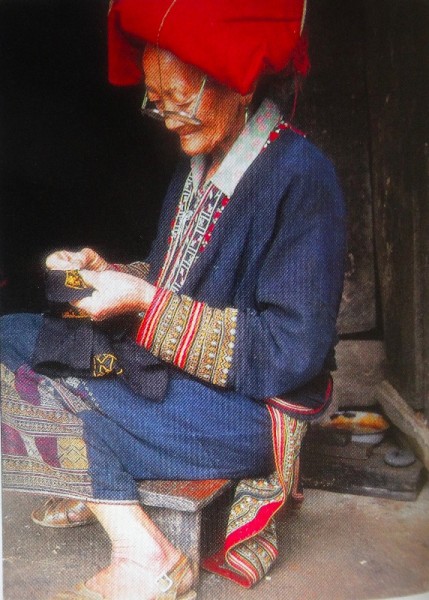
Photo of 77-rear old Red Dao woman. Not my picture but taken from the brilliant book “Textiles: A World Tour” by Catherine Legrand (T & H, 2008)
Couldn’t we make a little trip to Sa Pa I asked, as if it was the equivalent to making a detour from John Lewis and popping down Regent Street to Anthropologie. Not really came the reply, given that Sa Pa is so much North Vietnam that it’s practically in China – some 350 km from Hanoi. (That’s roughly the distance from London to Middlesborough or from London to the sea beyond Land’s End, just to give bit of perspective). Even worse, not only was Sa Pa a long way away but part of that route was along precipitous and not always perfect mountain roads and I’ve since read from the guidebook that January/February, though the best time to go in terms of not being too touristy is the worse time in terms of weather when there is often thick fog and the temperature is usually below freezing. A little day trip was definitely out.
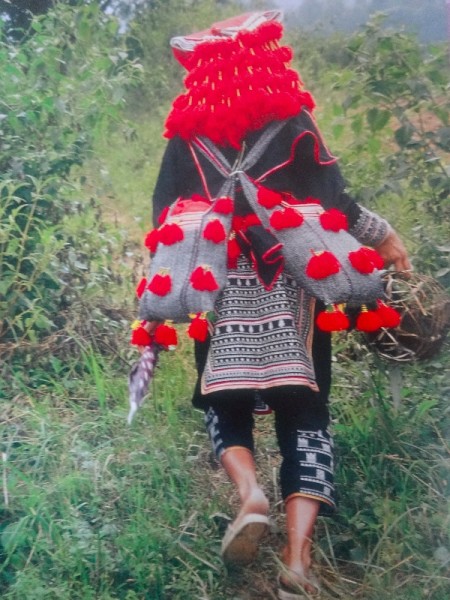
Picture of Red Dao woman on the way to market and showing her headdress of multiple scarves and tassels. (Once again this is not my photo but is taken from the excellent “Textiles: A World Tour” by Catherine Legrand (T & H, 2008)
Daughter No 2 has been to Sa Pa several times – once on the overnight sleeper (a practical but not elegant experience) and other times with a hired car and driver – and even then she had moments when her past flashed before her as the turn of the steering wheel mismatched the curve of the road.
Photo 1: Red Dao embroidered shoulder bag
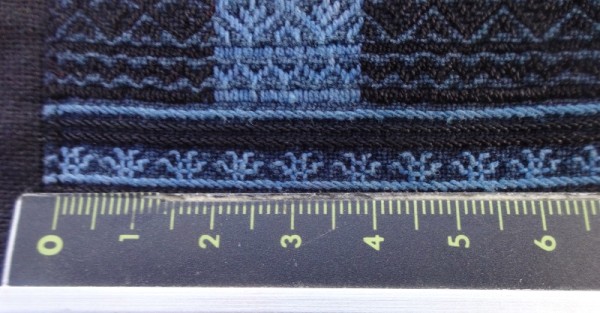
Photo 3: Red Dao embroidered shoulder bag: ever finer detail to show how tiny and neat the stitches are
She last went in Autumn when one of her friends came out from the UK and the two of them got chatting with a group of Red Dao ladies who during the day occupy a booth outside the Eco Lodge, just to the north of Sa Pa town. (The Red Dao have been forbidden to go into the lodge as tourists complain about them being too pushy – which is rich really as tourists love nothing more than walking through their villages and watching them about their everyday life and offering to buy their wedding trousseau, etc., etc.)
I say chatting – and that is chatting in English (and they could probably chat in French too) yet remarkably these women are largely illiterate, cannot write and have had no, or almost no. formal education. The English they have, they have picked up through interactions with tourists – a reinforcement of the idea that the best way to learn a language is to just throw yourself in and get talking.
Well, it must have been a slack day in the Red Dao booth – or Daughter No 2 ‘s + friend’s conversation must have offered the equivalent of a couple of hour’s of evening class – for The Red Dao ladies decided to leave their post and tag along for a walk into the countryside. They talked about having babies (they liked to stay in the village rather than go to a distant hospital) and dentists (they saved up cash for gold fillings which they preferred and which most proudly sported). But their fingers are never still and the end of this walk several of the women had made twisted grass horses for daughter No 2 and friend. Naturally, daughter No 2 bought several of their embroidered bags. Why wouldn’t you?
The Red Dao are one of the most distinctive of the ethnic groups, and in large part this is down to their headdresses. Their hair is wound up and secured under a red scarf which sits cushion like with large tassels trailing over the shoulders. At home they just wear one scarf but when they go to Sa Pa to market, they add several more, one on top of another for extra glamour. Plucking eyebrows and hair from their natural hairline opens up the face and draws more attention to the bright red headdress and its trailing tassels.
The embroidery of their clothes is more subtle, often because they are very happy for the indigo of the garment to leak into the colour of the thread – orange fades to a mottled yellow, yellow turns to green and red becomes maroon, while white turns pale blue. This is evident from the embroidery on the little bags shown here. Sometimes the blue of the fabric has almost overwhelmed the embroidery and you have to look with a magnifying glass to see the tiny – very tiny – stitches, especially in dark thread. Do compare the size of the motifs with the ruler I’ve included in most of the photographs. At first I somewhat disdainfully thought the bags were made with woven fabric – a fine brocade. It took me sometime examining the stitches and where I could looking at the wrong side before I appreciated how very intricate was the work and how very very small were the stitches. I was – and am still – hugely impressed. Lovely as these bags are I think the quality of the work is so high it should be mounted and framed – I can’t bear the thought of putting coins in the purses or filling the bag with the handbag paraphernalia.
But the embroidery is not just decorative, many motifs have traditional meanings – some motifs represent nature, others symbolise the Taoist balance between people and landscape. The symbols are often passed between the ethnic groups as women imprint individuality on what they wear. On the little bags shown here, I can see what I think are pine trees, peach blossom, possibly banyan trees (the tree under which Buddha sat) and the gibbon’s paw – what we call the swastika. Other embroidery looks like variations on basic themes. All is so beautifully done that it makes machine made braid on a couture suit look crude and heavy handed.
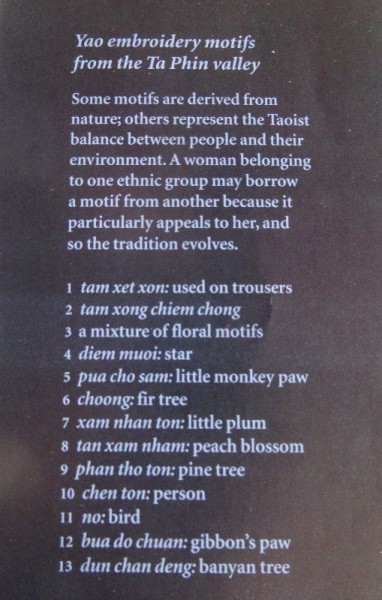
Red Dao embroidery: meaning of motifs shown in the above photograph (taken from Catherine Legrand’s Textiles: A World Tour; T & H 2008)
Just to be clear: the Red Dao (pronounced Zao,) are also known as Dzao or Yao (the latter term is used in my constant companion, the unparalleled and enlightening Catherine Legrand’s Textiles, A World Tour, T & H, 2008).
Sa Pa has one of the largest ethnic populations in Vietnam, with 15% of the 36,000 people living in and around the town so defined. Of this 15%, half belong to the Hmong group (mainly the Black Hmong). The Red Dao tribe is one of the smaller groups.
For more about just some of the ethnic tribes see an earlier post of mine here or even better pick up a copy of Catherine Legrand’s ‘Textiles, A World Tour’, T & H, 2008 which has a fantastic overview of many more Vietnamese tribes and copious beautiful coloured drawings of their clothing complete with full descriptions. As the title suggests, the book covers stunning ethnic textiles from all over the world.
The jacket shown immediately above was photographed in an ‘antique’ shop in Saigon round the corner from our hotel. Wouldn’t you know it the woman in the shop greeted daughter No 2 enthusiastically, remembering she’d visited the shop before (and undoubtedly brought something). You travel half way round the world to find your daughter is well known in an antique shop – well better that than a bar…although now I come to think of it she’s probably well known in bars the length and breadth of SE Asia too – being one of the few woman in a male dominated sphere of action makes you very visible.)
But back to the embroidery – the Red Dao embroidery which we have is heavily indigo and the dye has obviously changed the colour of the thread used for embroidery. I’m uncertain whether this is a new trend or whether in their own garments (see this post’s first 2 photographs and the vintage jacket above) repeated washing reduces the indigo from intense midnight blue to a grey-black shade. Only the 2 little purses have white motifs. Was the white added after a first washing. Who knows? Perhaps before I mount the panels on the bags I’ll give them a few washes – without the addition of salt to fix the colour – and see what happens.
.

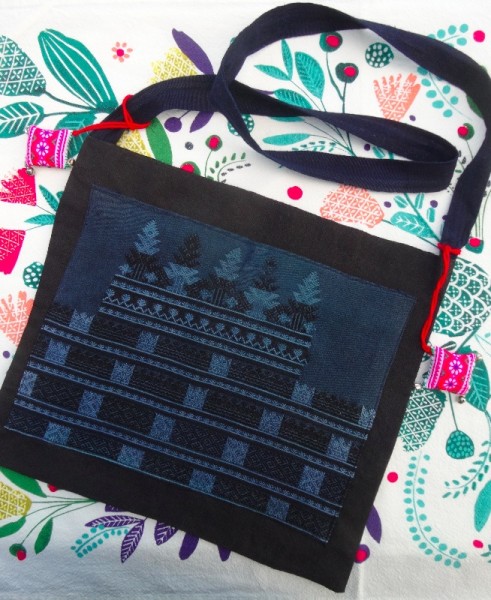
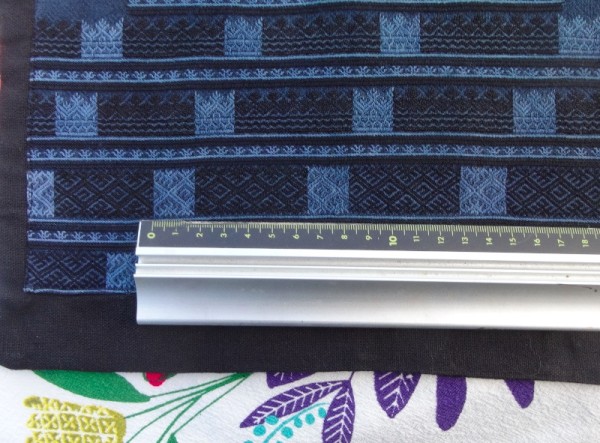
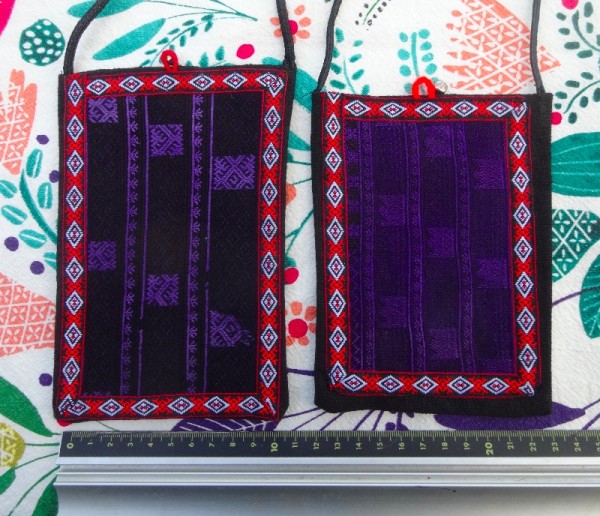
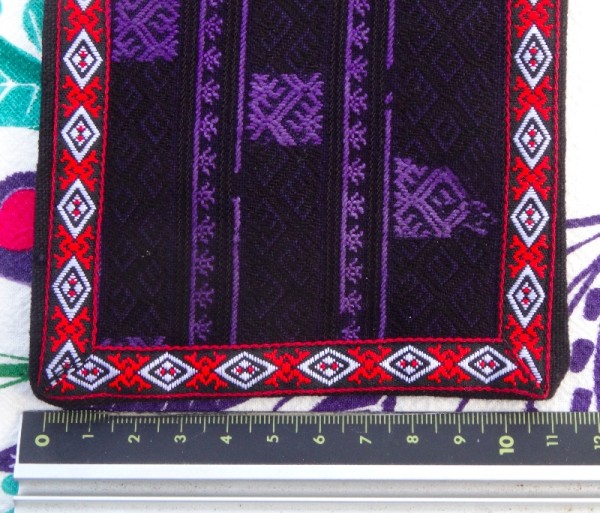
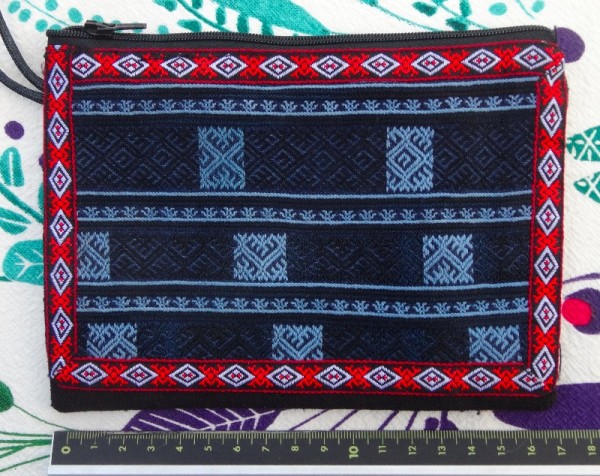
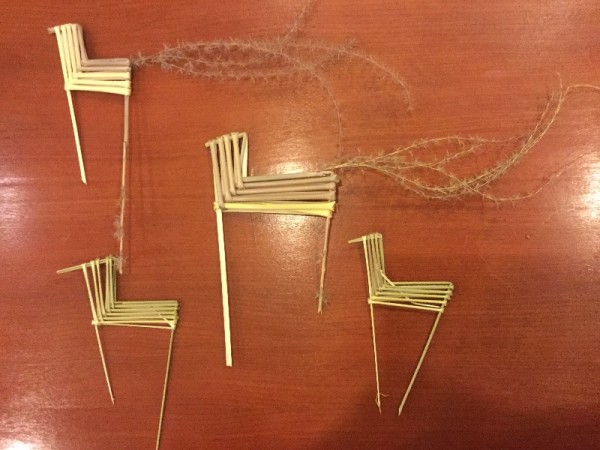
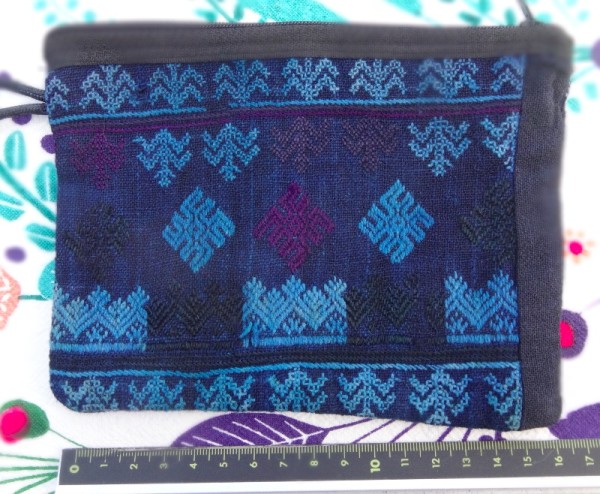
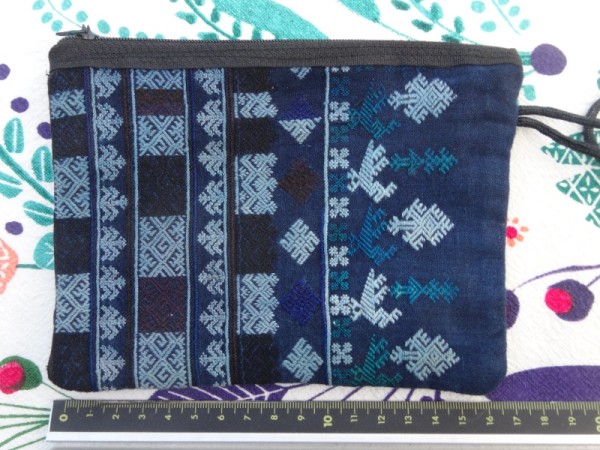
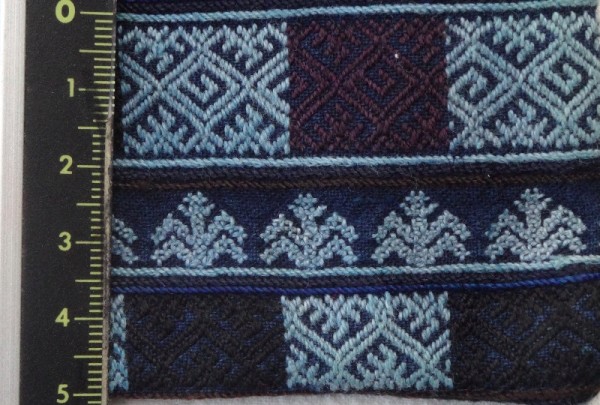
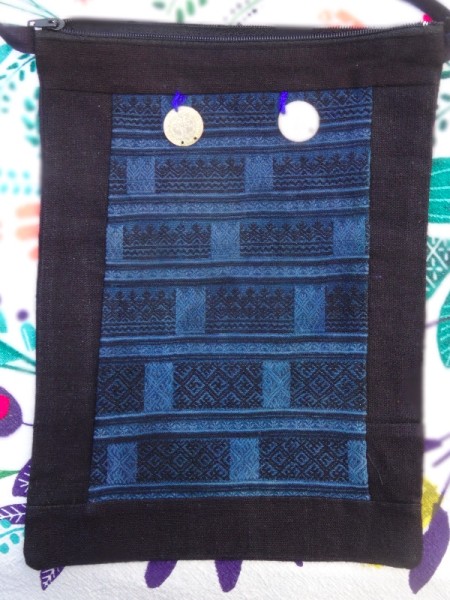
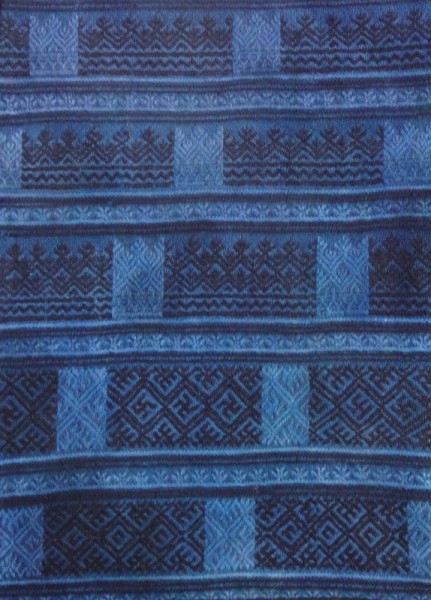
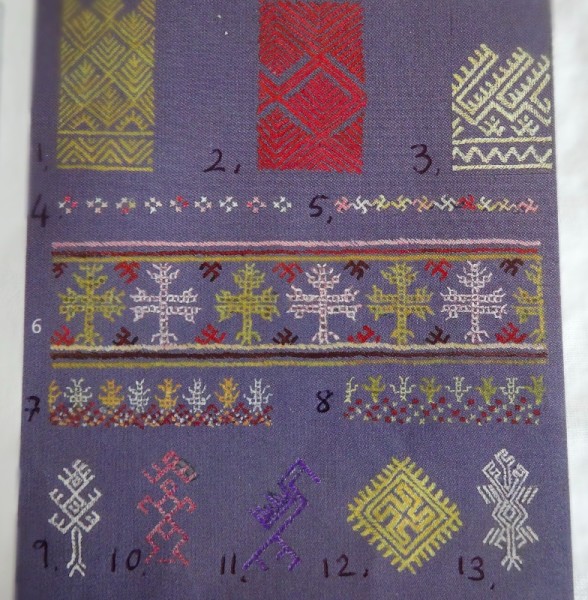
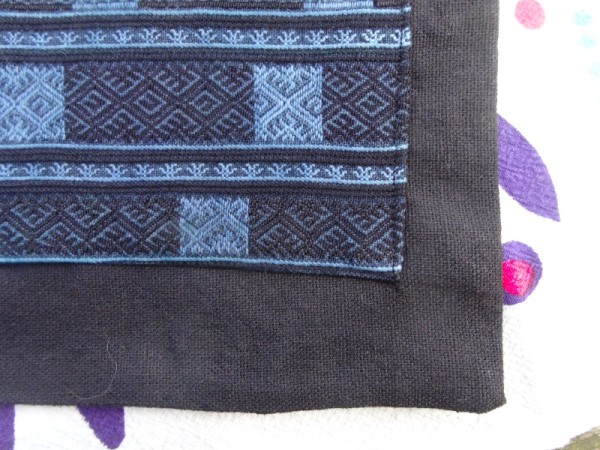
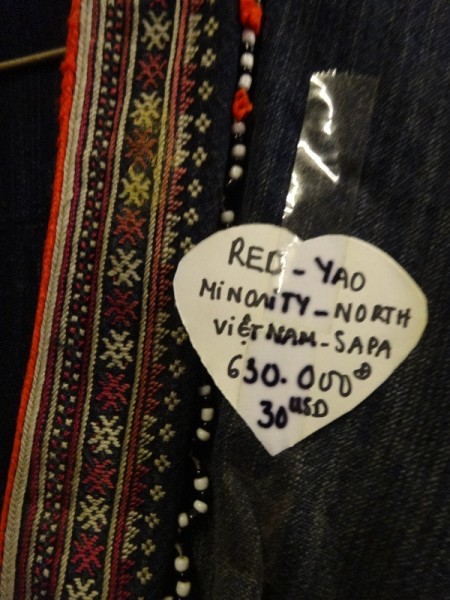
16 Comments
What beautiful work. I would not have been as restrained in my purchases!
Since I’ve been home I’ve wished I’d bought much more than I did – so may beautiful things. Such is life.
I can understand why Daughter vetoed the trip, if the roads are so wild, but at least she had some adventures to tell you about…
And with so much to do and see you have to draw a line somewhere.
What stunning headgear. I particularly like the back view, with not only the tasseled head dress but decorated bags too. X
Most tribes have lovely headgear but none in quite such a bright colour. Some like tassels, some like ribbons, some go in for silver coins and some use seeds and shells and the wonder is that they still dress in these traditional ways – long may it last.
What an amazing post! The embroidery is stunning.
And to think it took me a while before I realised it was done by hand!
Many thanks for such a very comprehensive, fascinating and informative post, Mary, and for referring us back to an earlier equally fascinating one. With your forensic eye for detail, I look forward to future ones illustrating your interpretation of Red Dao culture in your own work.
Other embroidery links: I subscribe to The Art of Science website (one of those many ‘hoops’ one jumps through after listening, last year, to an episode of BBC’s Radio 4’s “Private Passions”). The latest posting shows some of the work of Evelinn Kasikov, a contemporary textile artist. Very interesting, original embroidery.
I don’t think my work will ever reflect that shown here – it’s too fine and the stitches are too tiny for me.
Thank you for your recommendations – I have enjoyed looking at Evelinn Kasikov’s work – it’s always interesting to see other embroiderer’s work and what they do with it.
Hello Mary – Fascinating to read about the Red Dao ladies…. what quick minds they must have to master so many languages… their embroidery is exquisite too. Just think what most of us wear every day and the splendours of the Red Dao outfits…. Have fun….
Hello Lydia, lovely to hear from you again. Glad you’ve enjoyed the post. The Red Dao ladies are very impressive, I would have loved to have spoken to them myself at first hand and to have seen them sitting at their communal embroidery.
Mum, it makes me wish I had taken you there! Not possible on this trip, but maybe we will have to plan another. I know the Red Dao ladies I met would love to meet someone with such an interest in and understanding of their handicraft……most people they meet really don’t and are just looking for a bargain
What a lovely thought that I might go to Vietnam again and that I might even meet the ladies you met. As it was I had a wonderful time – it was one of those trips that just get richer the more I think about it. It is strange to think how circumstances came together for me to go – if Allegra had changed job just a matter of weeks after she did you would have been back in the UK. Both of you were very generous to me and it was a joy to see you with your Vietnam colleagues in a place that had been home to you for four years.
This fascinating sequence of your trip has been so vivid and in the now. Thank you so much for the pleasure. I am new to your blog and am enjoying all the older posts very much.
Thank you for your comment Louise – it is great to have new visitors to the blog and I am delighted to hear that you are enjoying trawling back through previous posts.